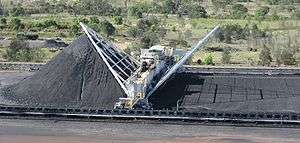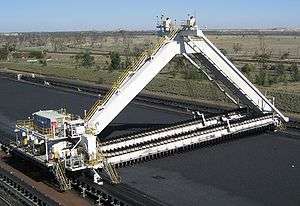Reclaimer
A reclaimer is a large machine used in bulk material handling applications. A reclaimer's function is to recover bulk material such as ores and cereals from a stockpile. A stacker is used to stack the material.

Reclaimers are volumetric machines and are rated in m3/h (cubic meters per hour) for capacity, which is often converted to t/h (tonnes per hour) based on the average bulk density of the material being reclaimed. Reclaimers normally travel on a rail between stockpiles in the stockyard. A bucket wheel reclaimer can typically move in three directions: horizontally along the rail; vertically by "luffing" its boom and rotationally by slewing its boom. Reclaimers are generally electrically powered by means of a trailing cable.
Reclaimer types
Bucket wheel reclaimers use "bucket wheels" for removing material from the pile they are reclaiming. Scraper reclaimers use a series of scrapers on a chain to reclaim the material.
The reclaimer structure can be of a number of types, including portal and bridge. Reclaimers are named according to this type, such as "Bridge reclaimer". Portal and bridge reclaimers can both use either bucket wheels or scrapers to reclaim the product. Bridge type reclaimers blend the stacked product as it is reclaimed..
Blending bed stacker reclaimers create reclaimed piles in a circular fashion. Whenever the material is laid down during the reclaiming process it creates a pile, these piles are moved through a conveyor system that rotates around the center of the pile to create a circle. This allows the pile to be evenly spread out during the reclaiming process and allows for the oldest material in the pile to be reclaimed before the newer material. During this process, a harrow tool is used to cut through the reclaimed material so that the material can be combined.[1] Some Blending bed reclaimers are equipped with rakes to ensure that no material gets stuck in the reclaiming process. These rakes are made of various materials and sizes based on the climate the reclaimer is located in. In below freezing temperatures, a harder material is used to create a rake with modified edges, which allow for any ice or debris to be broken.[2]
Cantilever chain reclaimers are designed to use longer booms. Cantilever chain reclaimers use a truss system that is connected to a liner and then to a chain, this chain is bolted onto the elevation chute and fixed to the reclaimer. The angle of this boom is then set by a cable-winch system and is supported using a cable system. With the cable, the boom can be lowered slightly during each reclaiming cycle. This chain system creates a push and pull effect that allows for any loose material to be collected and moved to the edge of the reclaimed pile. After the loose material is collected it is lifted and moved for further processing. [3]
Reclaimer applications
A reclaimer is used for reclaiming applications, these applications can have low, medium, and high material flow rates. These machines are made up of a bucket-wheel, a counterweight boom, and a rocker. A reclaimer uses a conveyor system to move any material reclaimed from the boom to its specific pile. When the reclaiming load rate is high or a longer boom is required, the machine is assembled differently to accommodate for the larger load and flow rate. In the event of high material flow rate a combination of a boom and bucket wheel is used.[2]
Control systems
Stackers and Reclaimers were originally manually controlled manned machines with no remote control. Modern machines are typically fully automated with their parameters (for stacking or reclaiming) remotely set. Some older reclaimers may still be manually controlled, as reclaiming is more difficult to automate than stacking because the automatic detection of pile edges is complicated by different environmental conditions and different bulk materials.
See also
References
- "Blending bed stacker reclaimer | Bruks Siwertell". www.bruks-siwertell.com. Retrieved 2020-02-13.
- S.p.A, Tenova. "Reclaimers - TENOVA". www.tenova.com. Retrieved 2020-02-14.
- "Cantilever chain reclaimer | Bruks Siwertell". www.bruks-siwertell.com. Retrieved 2020-02-13.
